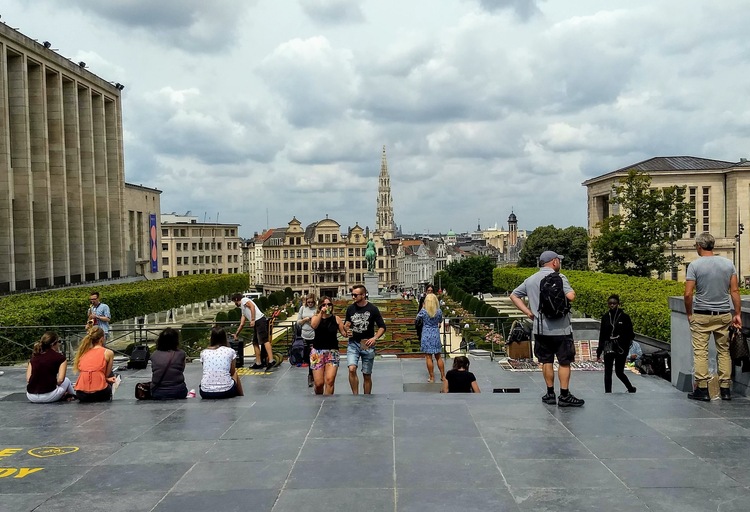
Mont Des Arts / Kunstberg
Go all the way to the top of the steps and then turn around to enjoy the view. I hope you’re here on a clear, blue-sky day but even on a cloudy, foggy day you’ll see the spire of City Hall towering above Lower Town with the golden 12m tall statue on top of St Michael, the patron saint of Brussels, slaying a demon. You may need to go a few steps to the right to be able to see the Basilica of the Sacred Heart all the way on the other side of the city. It’s on top of another hill, the Koekelberg, and is the 5th largest church in the world, after the Basilica of Notre-Dame de la Paix in Ivory Coast, St Peter's in Rome, St Paul's in London and Santa Maria Dei Fiori in Florence. The Brussels Basilica is much younger than those, it was one of the many late 19th century development projects of King Leopold II, the so-called Builder-King. King Leopold II would never see The Basilica of the Sacred Heart, however, as it was only built in the 1920s and 1930s and finished after the 2ndWorld War in Art Deco style. The Basilica can be visited and offers a beautiful panorama of the Brussels skyline.
You’ll hear me mentioning King Leopold II a few times more. He was very ambitious, I often use the word megalomaniac when talking about him. As he often said himself Belgium was too small a country for his ambition. That is why he obtained his own personal colony in the heart of Africa, a very large area occupying almost all of the Congo River basin. He was obsessed with making the young country of Belgium (independent since 1830) an important European player and Brussels a great European capital. Paris was his shining example. The Basilica of the Sacred Heart, or Sacré Coeur on top of the hill (just like Paris) is one example, and right here this other hill, the Arts Mount was supposed to be another. The slope in front of us was a densely populated working-class neighborhood until the King Leopold II envisioned an Arts Quarter here, just like in Paris or London. He bought the entire neighborhood and razed it to the ground. But, as happened often, the government and city didn’t want to fund his plans. It’s only after the 2nd World War that the buildings that you see today were built. Unfortunately, that time was not exactly known for its wonderful architecture. On your lefthand side with the beautiful street art is the Royal Library of Belgium, the buildings on the righthandside a conference center.
-
INTRODUCCIÓN
-
EXPOSICIÓN DE LA GRANJA QUEBEC DE FREDERICK Y ALICE REINHARDT
-
FLUYENDO A TRAVÉS DEL TIEMPO
-
LA IGLESIA
-
LA TRANSICIÓN
-
EXPOSICIÓN: LA SALA DEL MOLINO
-
EXPOSICIÓN DEL NAVIGANT: EL TESORO DE LA VIDA
-
LA ESCALERA
-
EXPOSICIÓN DE BÉISBOL
-
VIVIENDA DE TRES NIVELES
-
MOLINOS A LO LARGO DEL BLACKSTONE
-
EXPOSICIÓN: EL AULA PARROQUIAL- (c.1929)
-
INDUSTRIALES DE WOONSOCKET
-
SALÓN DE LA UIT
-
EXPOSICIÓN DE VETERANOS “LT. GEORGES DUBOIS”